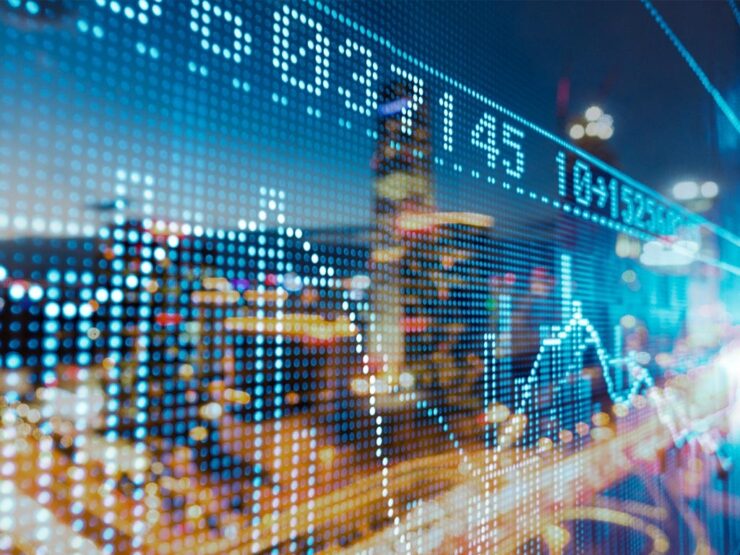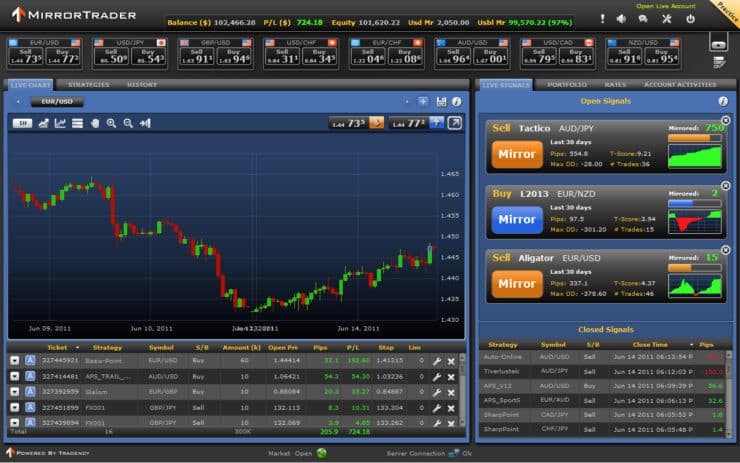Don’t invest unless you’re prepared to lose all the money you invest. This is a high-risk investment and you are unlikely to be protected if something goes wrong. Take 2 minutes to learn more
Algorithmic trading – or simply ‘algo trading’, is the process of allowing a pre-programmed computer to research and trade on your behalf. The overarching concept is that the underlying algorithm can process market data significantly faster than you or I.
As a result, algorithmic trading programs are highly sought-after by investors of all shapes and sizes.
That said, the algorithm supporting the trading software is only as good as the person who built it. In other words, if the software has been designed poorly, the likelihood is that it will lose you money.
Fancy finding out how algo trading works? If so, read our Learn 2 Trade 2025 Guide On Algorithmic Trading.
Note: If you don’t feel comfortable allowing a program to place trades on your behalf, it might be worth considering a signal service. This is where the automated algorithm suggests trades based on market conditions – which you then need to act on manually.
AvaTrade - Established Broker With Commission-Free Trades

- Minimum deposit of just 250 USD to get lifetime access to all the VIP channels
- Awarded Best Global MT4 Forex Broker
- Pay 0% on all CFD instruments
- Thousands of CFD assets to trade
- Leverage facilities available
- Instantly deposit funds with a debit/credit card

What is Algorithmic Trading?
In its most basic form, algorithmic trading is an automated trading strategy that relies exclusively on computers. More specifically, the underlying technology will scan thousands of markets at any given time, constantly looking for potential trading opportunities. When the software believes that a favourable trade is in the making, it will then place the respective market orders autonomously. As such, you stand to make money without needing to lift a single finger.
With that being said, the difficult part is designing and building an algorithmic trading program that has the capacity to outperform the market. After all, the software does not have the capacity to ‘think’ per-say, as it is merely instructed to follow a set of pre-defined conditions. This is the same as any software program that is based on algorithms or machine learning technologies.

For example, not only will the software have the potential to scan thousands of financial instruments on a 24/7 basis, but it can do so without experiencing fatigue, irrationality, or human emotion. Furthermore, there is no limit to the number of trading strategies that the algorithmic bot can be instructed to follow. This might include strategies centring on arbitrage trading, mean reversion trading, momentum trading, and even order chasing.
Pros and Cons of Algorithmic Trading
- Algorithms can process significantly more data than a human trade
- The underlying software scans thousands of markets at any given time
- Trades 100% anonymously
- Places orders in lightning speed
- Operates 24/7 without fatigue or irrationality
- No limit to the number of trading strategies the technology can employ
- You will lose money if the algorithm has been designed poorly
- Some algorithmic trading providers in the online space are scams
How Does Algorithmic Trading Work?
In order to understand how algorithmic trading actually works, we need to split the two terms – ‘algorithmic’ and ‘trading’. In doing so, we can unravel the fundamentals of how the software is governed.
Algorithmic
As the name implies, algorithmic trading is backed by an algorithm. For those unaware, algorithms are present in virtually every walk of life in the online arena. For example, when you browse through Amazon and see that the website is suggesting products and services that you are interested in, this is based on an algorithm that looks at historical data.
This might be previous searches or purchases you have made at the site, or even the length of time you have spent on specific product pages. Either way, it’s anything but a coincidence that the suggested items you see are closely aligned with your personal wants and needs.
So how does this relate to algorithmic trading? Well, instead of analyzing your shopping preferences, the underlying technology will scan historical statistics in the financial markets. And when we say ‘scan’. we mean high-level research on historical pricing trends, and how these trends relate to current market activity.
At the forefront of this are metrics like trading volumes, volatility levels, liquidity, and market sentiment. The technology is subsequently supported by a plethora of advanced chart reading tools – such as the RSI (Relative Strength Index), the MACD (Moving Average Convergence Divergence), and Bollinger Bands.
Trading
The second segment of the phenomenon centres on ‘trading’. That is to say, once the algorithmic trading software has flagged a potential entry point on an asset it is tracking, the system will then proceed to act on it. In the case of a human trader, this would require a long and drawn out thought-process to determine which entry and exit prices to initiate.
For example, the trader would need to assess the best price to execute the order, as well as a trigger point to assign to the stop-loss and take-profit orders.

What this means for you as an investor is that a proven algo trading protocol is tasked with making you money in an autonomous manner. As such, you stand the chance to make long-term gains without needing to have any experience of how the financial markets work.
What-If Scenarios
If you’ve previously used Microsoft Excel in a work-based setting, then you might already have a firm grasp of how what-if scenarios work. If you do, this is great – as this sits at the core of how algorithmic trading platforms function.
For those unaware, the what-if function seeks to ‘action’ something when a pre-defined condition is met. In a real-world example, let’s say that you drink a certain brand of bottled water each and every day. As soon as you are down to your last bottle, you drive to your nearest shop and buy another two boxes.
The ‘what’ part of the equation is you going out to buy more bottled water – which you do when the ‘if’ part of the equation is triggered. In this example, the ‘if’ relates to your stocks of bottled water going down to just one unit.

In the context of algorithmic trading, the ‘what’ refers to the act of placing a trade. This is executed automatically when the ‘if’ is triggered, which might be a technical indicator that spots a potential trading opportunity.
To ensure you understand how the what-if function works when trading via a pre-conditioned algorithm, check out the example below.
- The algo trading software is programmed to analyze NYSE-listed stocks
- One of its pre-programmed conditions is to evaluate the RSI, which it does 24 hours per day
- The ‘if’ part of the algorithm is an RSI of 71
- The ‘what’ part of the algorithm is to place a ‘sell’ order
- Also part of the ‘what’ function are suitable entry and exit orders
As you can see from the above, the what-if function allows the investor to capitalize on blue-chip stocks when the RSI exceeds 70. As this indicates that the asset is overbought, a ‘sell’ order is the sensible option to take.
Benefits of Algorithmic Trading
Still not convinced about the potentialities of algorithmic trading? Below you will find some of the key reasons why pre-conditioned algorithmics consistently outperform human traders.
✔️ Unlimited Research Potential
The first benefit that springs to mind when relying on an algo trading protocol is its capacity to perform an unlimited amount of research. As we often note in our Learn 2 Trade guides, seasoned investors will often niche down to a select number of asset classes.
For example, by focusing exclusively on gold and silver, this allows you to gain expertise in the hard metals space. Crucially, we suggest niching down as it is beyond the realms of possibility to research each and every asset class in the investment arena. If you attempted this, you’d essentially be a Jack of all trades and master of none.
With that being said, algorithmic trading software is not bound by the same limitations as the human investor. On the contrary, it can scan thousands of individual markets at any given time – with virtually no threat of ‘information overload’.
✔️ Trade 24 Hours Per Day
Not only are human traders capped to a certain amount of research hours per day, but this is also the case with when placing orders. For example, let’s take a typical 8-hour day for a full-time forex trader. The individual might spend a number of hours scanning the markets, and the rest of the day acting on these findings.
On the one hand, it is true that skilled traders are known to make a very generous living manually buying and selling assets. On the other hand, imagine how much a seasoned trader would make if they were able to research and trade 24 hours per day – 7 days per week?
Sure, this is again beyond the realms of possibility for the human brain – but not a well-programmed algorithmic trading protocol. As such, by utilizing an algo trading bot that works for your personal investment needs, you can effectively trade 24/7.
✔️Avoid Irrationality and Human Emotion
One of the biggest barriers facing human traders is that of emotions. Even seasoned traders let emotions get the better of them from time to time, which in turn can be catastrophic. Let’s take the coronavirus pandemic as a prime example.
Nobody could have predicted that the likes of the S&P 500 would have shed near-on 30% in the space of 1-2 weeks. In turn, those holding large positions might have been tempted to step aside from their usual disciplined approach to trading, and instead make irrational investments to try and ‘win the money back’.
Crucially, an algorithmic trading bot is merely a piece of software that has been programmed to follow ‘what-if’ conditions. As such, it doesn’t care for emotions or irrationality.
✔️ Ideal for the Newbie Trader
A further benefit of algorithmic trading is that it allows you to engage with the global investment industry without having an ounce of knowledge or experience. Ordinarily, you would need to go through a long and cumbersome research process that can take many, many months to master.
At the forefront of this is learning how to read and understand charts, pricing trends, and technical indicators. However, none of this is required when allowing an algo trader to operate on your behalf, as the technology functions in an autonomous manner. This means that you can sit back and allow the bot to buy and sell assets without needing to lift a finger.
Algorithmic Trading Strategies
So now that you have an understanding of how algo trading software operates, we now need to discuss some of the strategies that the protocol will be programmed to execute.
Although there is no limit to the number of strategies that can be deployed, below you will find some commonly used examples.
🥇️ Momentum Trading
Momentum trading is a popular strategy used by seasoned traders, so naturally, it makes sense that algo systems use it too. For those unaware, momentum trading is the process of ‘jumping on a trend’ until the trend is no longer in play.
For example, let’s say that Apple stocks have been on an upward trajectory for four straight weeks, with no clear reason to believe that the trend will stop any time soon. With this in mind, the algorithmic trading protocol will seek to enter positions when a market correction occurs.

Similarly, this is also the case if the asset is in a bear market, albeit, the bot will place a sell order when the asset corrects in an upward direction.
🥇️ Arbitrage Trading
Arbitrage trading is a highly effective strategy that essentially guarantees a profit regardless of which way the markets go. The overarching concept is to benefit from an asset that is indifferently priced across two or more exchanges.
For example, let’s say:
- The ‘buy’ price of Nike stocks on Exchange 1 is $85.00
- The ‘sell’ price of Nike stocks on Exchange 2 is $85.20
In Layman’s terms, this means that you can place a buy order on Nike stocks at $85.00, and then a sell order at $85.20. As such, regardless of which way the markets move, you are making an ultra-small, but guaranteed profit of 0.24%.
There are a couple of important points to note about arbitrage trading.
Time Restrictions
Firstly, when opportunities do arise – they rarely do for more than a few seconds. This is far too small of a time frame for a human trader to place the required trades.
In fact, you might end up losing money if you are only able to get one of two trades placed at the required price. On the contrary, algorithmic trading software can place the necessary buy and sell orders in a matter of milliseconds.
Liquidity
Secondly, there will only be a certain amount of liquidity available – at the required entry points, on both the buy order at Exchange 1, and the sell order at Exchange 2. Not only does this mean that the human trader needs to calculate exactly how much they are able to put on each trade to maximize their profit, but again, they would need to do this in record speed.
By the time the human trader is able to do this, some, or all, of the liquidity will have been eaten up. With that said, the algorithmic trading bot will be able to achieve the above in milliseconds.
🥇️ Mean Revision Trading
An additional trading strategy that algorithmic software is able to deploy with ease is that of the mean revision. The centres on the theory that an asset will at some point in time revert back to its historical price average.
More specifically, although an asset might deviate from its historical price range, statistically – a major upward or downward breach should revert back the mean. For example, let’s say that the algorithmic bot has been assigned to trade the Dow Jones. To keep things simple, we’ll say that historically, the Dow trades within 5% of its 200-day moving average.
If the Doe Jones entered a short-term bear market – subsequently losing 20% in the space of two months, the algorithmic trading protocol might decide to place a buy order. It would do this because statistically, the likelihood is that the Dow Jones should revert back to its +/- 5% range of the 200-day moving average.
How to Find an Algorithmic Trading Provider?
If you’ve read our guide up to this point, you might be thinking that algorithmic trading is a sure-fire way for you to make guaranteed profits. Unfortunately, it’s not as straight forward as this. The reason for this is that the underlying software is only as good as the person, or group of people, that built it.

Note: If you don’t have time to perform research yourself, you will find our three top-rated algorithmic trading providers at the bottom of this page.
✔️ Reputation
A logical starting point is to do some homework on the credentials of the algo trading provider. The internet is packed with reviews and ratings, so it’s well worth seeing what past and current subscribers say about the provider.
✔️ Price
When it comes to pricing, this is a difficult metric to assess. For example, would you prefer to spend $100 on an algo trading provider that loses you money, or $2,000 on a platform that makes monthly returns of 60%? Crucially, if you can verify that the provider’s claims are valid, you should be prepared to pay a higher price.
✔️ Demo Facility
We would argue that the presence of a demo facility is potentially the most important metric to look out for. In doing so, you will have the chance to test the algorithmic trading software out before sending it into the wild. Crucially, if you find that the bot doesn’t perform how you want it to, you can cut the cord by ensuring it doesn’t get to trade with your hard-earned money.
✔️ Free Trial
On top of a demo facility, we also prefer algo trading sites that offer a free trial of some sort. For example, if the platform offers a 30-day money-back guarantee, this will allow you to get a refund on your subscription.
✔️ Monthly Subscription
Without a doubt, you are best advised to choose an algorithmic trading provider that operates on a monthly subscription model. The reason for this is that the provider will be motivated to make necessary tweaks and improvements on a consistent basis.
If it doesn’t, then the provider knows that it will lose paying customers. Crucially, if you use a provider that charges a large one-off fee, you’re essentially stuck in limbo if it turns out the algo bot is below-par.
In-House Algo Trading or Broker Compatibility
It is also important to spend some time thinking about how your trades will actually be placed. After all, the only way to trade assets online is to use a broker.
In this sense, you have two options – a provider that places trades in-house, or one that allows you to connect the bot to your personal trading accounts.
In-House Algo Trading
Some algorithmic trading platforms provide an all-in package. By this, we mean that the provider will ensure that automated trades are placed with its own brokerage accounts. In doing so, you will then be entitled to your share of the profits – less commission.
For example, let’s say that you invest $5,000 with the provider at a commission rate of 10%. If in the month of May the algo software makes a return of 45%, this amounts to a profit of $2,250. once you subtract the commission of $225, this leaves you with a tidy profit of $2,025.
Broker Compatibility
Some traders prefer to have more control over their algo software investments. As such, they opt to use a provider that offers broker compatibility. In Layman’s terms, this means that the algorithmic bot can be linked with your personal brokerage accounts.
In most cases, the software will be compatible with either MT4 or MT5, meaning you can use it at hundreds of online brokers. Moreover, you will have full control over the entire investment process – so you get a full birds-eye view of what the bot is doing.
Best Algorithmic Trading Providers of 2025
If you like the sound of having an algo bot trading on your behalf 24/7, below you will find our top three provider picks of 2025. As always, be sure to perform your own research prior to parting with your money.
1. Try the Best Crypto Bot!
More than just signals are required if you intend to take your round-the-clock cryptocurrency trading seriously. Because of this, we developed a cutting-edge cryptocurrency trading bot that enables you to automate trades based on current market conditions. Learn 2 Trade Algorithm, our most recent offering, runs on its own. It searches the market for profitable trading chances as one of the top crypto trading bots and immediately notifies our subscribers via Telegram. In other words, it is no longer necessary to overlook profitable trades or keep an eye on the markets. Also, our Learn 2 Trade Algorithm works with the top cryptocurrency exchanges in addition to Cornix. This implies that you can conduct trades automatically, without any human involvement.

- Service for copy trading
- Up to 40 trades Per month
- 79% Success rate
2. Profit Pros Make $1,500 To $4,200 Daily With The World’s Most Intelligent Trading Software
Our specialised trading technology monitors the world’s crypto and Profit Pros 24/7
Our massive data crunching mainframes spot patterns in the markets
Our patented ‘Profit Pros’ trading algorithm guarantees our users make over $2000 per day

- 88% Claimed Win Rate
- $/£ 250 Min Deposit
- Accepts Debit and Credit Card
3. Prime Advantage – Earn Up To $3,000 Per Day Starting Today
With Our FREE Auto Trading Software
Prime Advantage claims that its algo trading bot can scalp micro profits 3 millionths of a second faster than institutional traders. The team offers full technical support to ensure that you have an advantage over the markets at all times.

- Cutting-Edge Technology
- 5 Star Client Support
- 100% In-house Logistics
- Cryptocurrency trading only - no CFDs or forex
4. CFD Trader – Become Financially Independent With Online Trading
CFD Trader is suited to those of you that are yet to try an algorithmic trading system. With an entry-level investment of just €250, the platform utilizes an in-house trading strategy. This means that all trades will be executed on your behalf. Crucially, you can withdraw your investment out at any time.

- Direct free access to the #1 best CFD broker of UK
- 1 free 1on1 coaching call within the first 48 hours of signing-up
- A personal mentor that will help you week after week
5. Join Us and Start Getting Rich with Crypto Trader!
The Crypto Trader is a group reserved exclusively to people who jumped on the insane returns that Bitcoin offers and have quietly amassed a fortune in doing so. Our members enjoy retreats around the world every month while they make money on their laptop with just a few minutes of “work” every day
- Minimum deposit of $100
- Over 2,000 trading instruments
- Mobile app available
Conclusion
There can be no denying that algorithmic software can outperform the human trader in most areas. Whether it’s scanning thousands of markets on a 24/7 basis, deploying hundreds of technical indicators at any given time, or placing automated trades in a matter of milliseconds – there really is no limit to what algo bots can do.
After all, the underlying technology is simply performing what-if tasks – so you have the potential to make consistent gains without lifting a finger. However, you still need to spend ample time researching the credentials of your chosen algo trading provider, not least because the industry is fraught with scams.
To help you along the way, we have discussed three of our pre-vetted algo trading recommendations – all of which have a long-standing track record in the space.
AvaTrade - Established Broker With Commission-Free Trades

- Minimum deposit of just 250 USD to get lifetime access to all the VIP channels
- Awarded Best Global MT4 Forex Broker
- Pay 0% on all CFD instruments
- Thousands of CFD assets to trade
- Leverage facilities available
- Instantly deposit funds with a debit/credit card
